2014 SUBARU TRIBECA belt
[x] Cancel search: beltPage 86 of 426
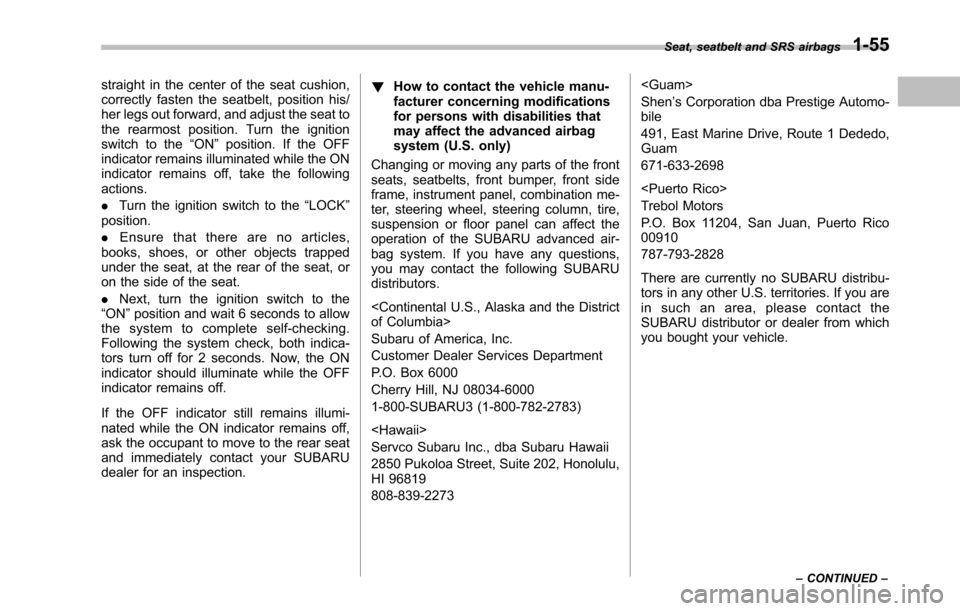
straight in the center of the seat cushion,correctly fasten the seatbelt, position his/her legs out forward, and adjust the seat tothe rearmost position. Turn the ignitionswitch to the“ON”position. If the OFFindicator remains illuminated while the ONindicator remains off, take the followingactions.
.Turn the ignition switch to the“LOCK”position.
.Ensure that there are no articles,books, shoes, or other objects trappedunder the seat, at the rear of the seat, oron the side of the seat.
.Next, turn the ignition switch to the“ON”position andwait 6 seconds to allowthe system to complete self-checking.Following the system check, both indica-tors turn off for 2 seconds. Now, the ONindicator should illuminate while the OFFindicator remains off.
If the OFF indicator still remains illumi-nated while the ON indicator remains off,ask the occupant to move to the rear seatand immediately contact your SUBARUdealer for an inspection.
!How to contact the vehicle manu-facturer concerning modificationsfor persons with disabilities thatmay affect the advanced airbagsystem (U.S. only)
Changing or moving any parts of the frontseats, seatbelts, front bumper, front sideframe, instrument panel, combination me-ter, steering wheel, steering column, tire,suspension or floor panel can affect theoperation of the SUBARU advanced air-bag system. If you have any questions,you may contact the following SUBARUdistributors.
Subaru of America, Inc.
Customer Dealer Services Department
P.O. Box 6000
Cherry Hill, NJ 08034-6000
1-800-SUBARU3 (1-800-782-2783)
Servco Subaru Inc., dba Subaru Hawaii
2850 Pukoloa Street, Suite 202, Honolulu,HI 96819
808-839-2273
Shen’s Corporation dba Prestige Automo-bile
491, East Marine Drive, Route 1 Dededo,Guam
671-633-2698
Trebol Motors
P.O. Box 11204, San Juan, Puerto Rico00910
787-793-2828
There are currently no SUBARU distribu-tors in any other U.S. territories. If you arein such an area, please contact theSUBARU distributor or dealer from whichyou bought your vehicle.
Seat, seatbelt and SRS airbags1-55
–CONTINUED–
Page 87 of 426

1-56Seat, seatbelt and SRS airbags
!Operation
1) Driver’s side2) Passenger’s side
The SRS airbag can function only whenthe ignition switch is in the“ON”position.
The SUBARU advanced frontal airbag
system is designed to determine theactivation or deactivation condition of thefront passenger’sSRSfrontalairbagdepending on the total load on the frontpassenger’s seat monitored by the frontpassenger’s occupant detection systemweight sensor. For this reason, only thedriver’s SRS frontal airbag may deploy inthe event of a collision, but this does notmeanfailure of the system.
If the front sub sensors located on bothsides of the radiator panel and the impactsensors in the airbag control moduledetect a predetermined amount of forceduring a frontal collision, the controlmodule sends signals to the airbagmodule(s) (only driver’s module or bothdriver’s and front passenger’s modules)instructing the module(s) to inflate theSRS frontal airbag(s). The driver’s andfront passenger’s SRS frontal airbags usedual stage inflators. The two inflators ofeach airbag are triggered either sequen-tially or simultaneously, depending on theseverity of impact, backward-forward ad-justmentof the driver’s seat position andfastening/unfastening of the seatbelt in thecase of the driver’s SRS frontal airbag anddepending on the severity of impact andthe total load on the seat in the case of thefront passenger’s SRS frontal airbag.
After deployment, the SRS airbag imme-diately starts to deflate so that the driver’svision is not obstructed. The time requiredfrom detecting impact to the deflation ofthe SRS airbag after deployment is short-er than the blink of an eye.
When only the driver’s SRS frontal airbagdeploys and both the driver’s and frontpassenger’s SRS frontal airbags deploy,the driver’s and front passenger’s seatbeltpretensioners operate at the same time.
Although it is highly unlikely that the SRSairbag would activate in a non-accidentsituation, should it occur, the SRS airbagwill deflate quickly, not obscuring visionand will not interfere with the driver’sability to maintain control of the vehicle.
When the SRS airbag deploys, a sudden,fairly loud inflation noise will be heard andsome smoke will be released. Theseoccurrencesare a normal result of thedeployment. This smoke does not indicatea fire in the vehicle.
CAUTION
Do not touch the SRS airbag systemcomponents around the steeringwheel and dashboard with barehands right after deployment. Doingso can cause burns because the
Page 88 of 426

components can be very hot as aresult of deployment.
The driver’s SRS frontal airbag and frontpassenger’s SRS frontal airbag are de-signed to deploy in the event of anaccident involving a moderate to severefrontal collision. They are not designed todeploy in most lesser frontal impactsbecause the necessary protection can beachieved by the seatbelt alone. Also, theyare not designed to deploy in most side orrear impacts or in most rollover accidentsbecause deployment of only the driver’sSRS frontal airbag or both driver’s andfront passenger’sSRSfrontalairbagswouldnot help the occupant in thosesituations. The driver’s and front passen-ger’s SRS frontal airbags are designed tofunction on a one-time-only basis.
SRS airbag deployment depends on thelevel of force experienced in the passen-ger compartment during a collision. Thatlevel differs from one type of collision toanother, and it may have no bearing onthe visible damage done to the vehicleitself.
!Examples of accidents in whichthe driver’s/driver’s and frontpassenger’s SRS frontalairbag(s) will most likely deploy
A head-on collision against a thick con-crete wall at a vehicle speed of 12 to 19mph (20 to 30 km/h) or higher activatesonly the driver’s SRS frontal airbag or bothdriver’s and front passenger’s SRS frontalairbags. The airbag(s) will also be acti-vated when the vehicle is exposed to afrontal impact similar in fashion andmagnitude to the collision describedabove.
!Examples of the types of acci-dents in which it is possible thatthe driver’s/driver’s and frontpassenger’s SRS frontalairbag(s) will deploy
Only the driver’s SRS frontal airbag or
Seat, seatbelt and SRS airbags1-57
–CONTINUED–
Page 89 of 426
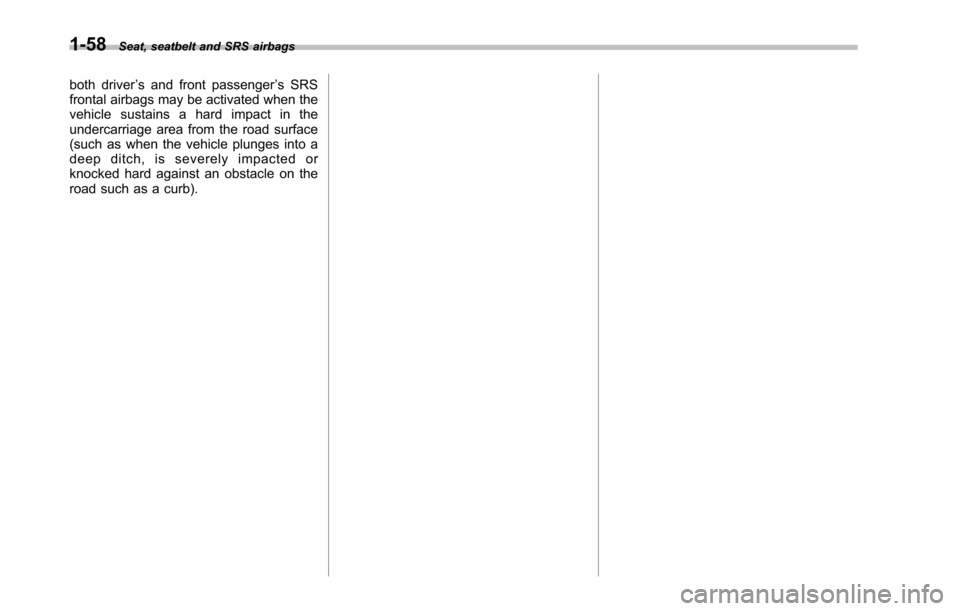
1-58Seat, seatbelt and SRS airbags
both driver’s and front passenger’s SRSfrontal airbags may be activated when thevehicle sustains a hard impact in theundercarriage area from the road surface(such as when the vehicle plunges into adeep ditch, is severely impacted orknocked hard against an obstacle on theroad such as a curb).
Page 90 of 426
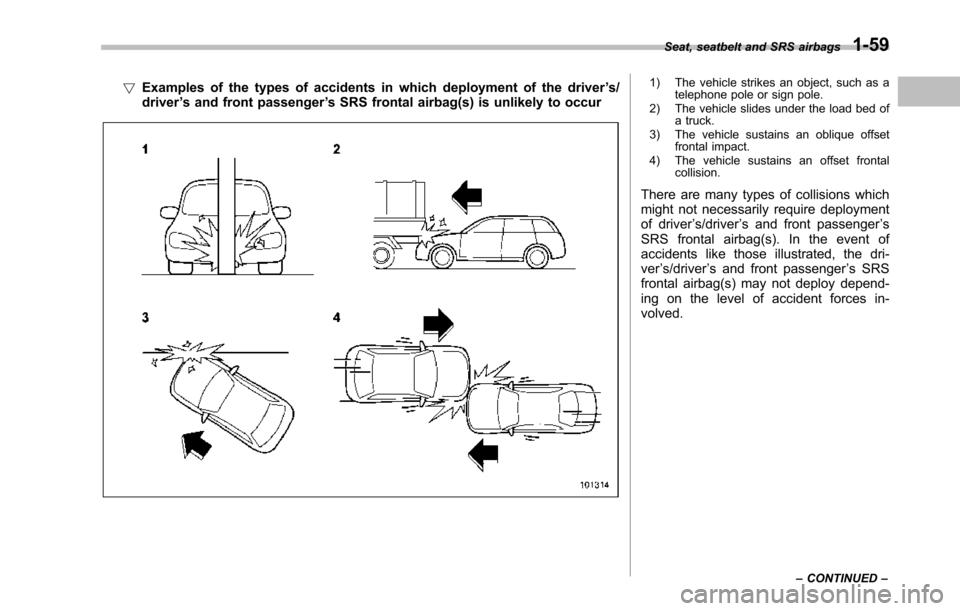
!Examples of the types of accidents in which deployment of the driver’s/driver’s and front passenger’s SRS frontal airbag(s) is unlikely to occur
1) The vehicle strikes an object, such as atelephone pole or sign pole.2) The vehicle slides under the load bed ofa truck.3) The vehicle sustains an oblique offsetfrontal impact.4) The vehicle sustains an offset frontalcollision.
There are many types of collisions whichmight not necessarily require deploymentof driver’s/driver’s and front passenger’sSRS frontal airbag(s). In the event ofaccidents like those illustrated, the dri-ver’s/driver’s and front passenger’s SRSfrontal airbag(s) may not deploy depend-ing on the level of accident forces in-volved.
Seat, seatbelt and SRS airbags1-59
–CONTINUED–
Page 91 of 426
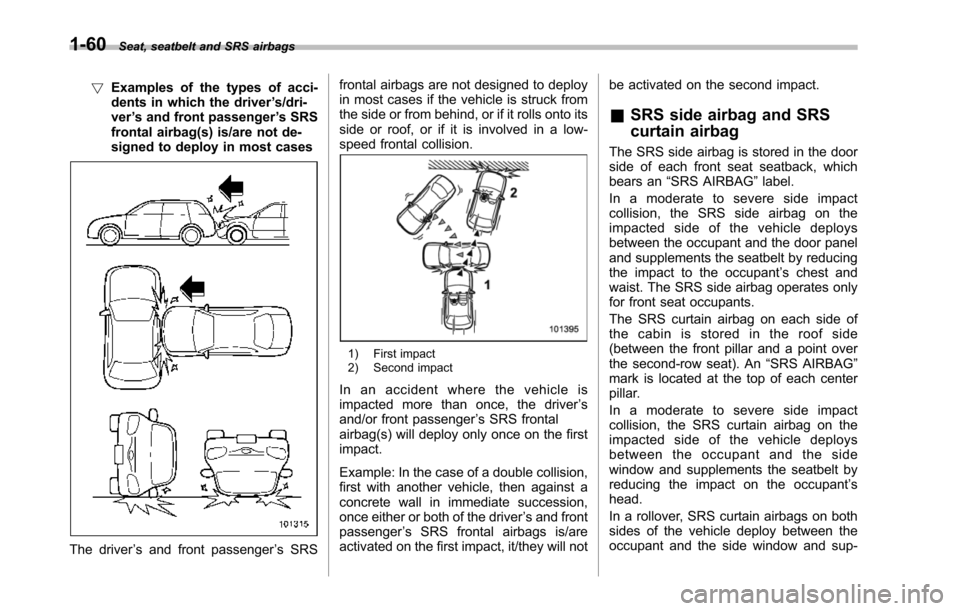
1-60Seat, seatbelt and SRS airbags
!Examples of the types of acci-dents in which the driver’s/dri-ver’s and front passenger’s SRSfrontal airbag(s) is/are not de-signed to deploy in most cases
The driver’s and front passenger’s SRS
frontal airbags are not designed to deployin most cases if the vehicle is struck fromthe side or from behind, or if it rolls onto itsside or roof, or if it is involved in a low-speed frontal collision.
1) First impact2) Second impact
In an accident where the vehicle isimpacted more than once, the driver’sand/or front passenger’s SRS frontalairbag(s) will deploy only once on the firstimpact.
Example: In the case of a double collision,first with another vehicle, then against aconcrete wall in immediate succession,once either or both of the driver’s and frontpassenger’s SRS frontal airbags is/areactivated on the first impact, it/they will not
be activated on the second impact.
&SRS side airbag and SRS
curtain airbag
The SRS side airbag is stored in the doorside of each front seat seatback, whichbears an“SRS AIRBAG”label.
In a moderate to severe side impactcollision, the SRS side airbag on theimpacted side of the vehicle deploysbetween the occupant and the door paneland supplements the seatbelt by reducingtheimpact to the occupant’s chest andwaist. The SRS side airbag operates onlyfor front seat occupants.
The SRS curtain airbag on each side ofthe cabin is stored in the roof side(betweenthe front pillar and a point overthe second-row seat). An“SRS AIRBAG”mark is located at the top of each centerpillar.
In a moderate to severe side impactcollision,the SRS curtain airbag on theimpacted side of the vehicle deploysbetween the occupant and the sidewindow and supplements the seatbelt byreducing the impact on the occupant’shead.
In a rollover, SRS curtain airbags on bothsides of the vehicle deploy between theoccupant and the side window and sup-
Page 92 of 426
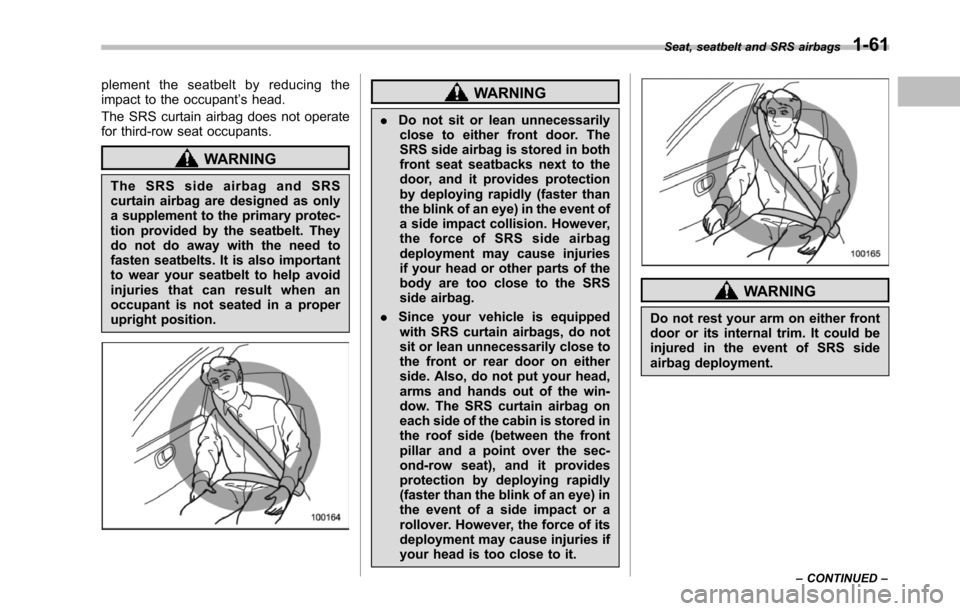
plement the seatbelt by reducing theimpact to the occupant’s head.
The SRS curtain airbag does not operatefor third-row seat occupants.
WARNING
The SRS side airbag and SRScurtain airbag are designed as onlya supplement to the primary protec-tion provided by the seatbelt. Theydo not do away with the need tofasten seatbelts. It is also importantto wear your seatbelt to help avoidinjuries that can result when anoccupant is not seated in a properupright position.
WARNING
.Do not sit or lean unnecessarilyclose to either front door. TheSRS side airbag is stored in bothfront seat seatbacks next to thedoor, and it provides protectionby deploying rapidly (faster thanthe blink of an eye) in the event ofa side impact collision. However,the force of SRS side airbagdeployment may cause injuriesif your head or other parts of thebody are too close to the SRSside airbag.
.Since your vehicle is equippedwith SRS curtain airbags, do notsit or lean unnecessarily close tothe frontor rear door on eitherside. Also, do not put your head,arms and hands out of the win-dow. The SRS curtain airbag oneach side of the cabin is stored inthe roof side (between the frontpillar and a point over the sec-ond-row seat), and it providesprotection by deploying rapidly(faster than the blink of an eye) inthe event of a side impact or arollover. However, the force of itsdeployment may cause injuries ifyour head is too close to it.
WARNING
Do not rest your arm on either frontdoor or its internal trim. It could beinjured in the event of SRS sideairbag deployment.
Seat, seatbelt and SRS airbags1-61
–CONTINUED–
Page 93 of 426
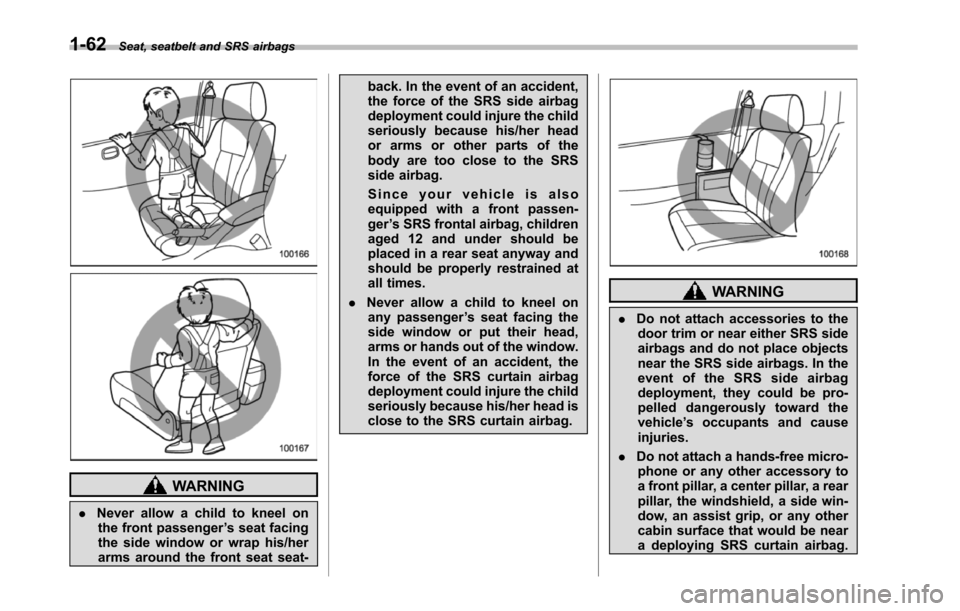
1-62Seat, seatbelt and SRS airbags
WARNING
.Never allow a child to kneel onthe front passenger’s seat facingthe side window or wrap his/herarms around the front seat seat-
back. In the event of an accident,the force of the SRS side airbagdeployment could injure the childseriously because his/her heador arms or other parts of thebody are too close to the SRSside airbag.
Since your vehicle is alsoequipped with a front passen-ger’s SRS frontal airbag, childrenaged 12 and under should beplaced in a rear seat anyway andshould be properly restrained atall times.
.Never allow a child to kneel onany passenger’s seat facing theside window or put their head,arms or hands out of the window.In the event of an accident, theforceof the SRS curtain airbagdeployment could injure the childseriously because his/her head isclose to the SRS curtain airbag.
WARNING
.Do not attach accessories to thedoor trim or near either SRS sideairbags and do not place objectsnear the SRSside airbags. In theevent of the SRS side airbagdeployment, they could be pro-pelled dangerously toward thevehicle’s occupants and causeinjuries.
.Do not attach a hands-free micro-phone or any other accessory toa front pillar, a center pillar, a rearpillar, the windshield, a side win-dow, an assist grip, or any othercabin surface that would be neara deploying SRS curtain airbag.